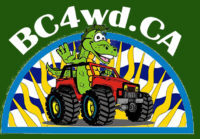I will admit that when Recovery Boards first appeared I considered them to be either a fad or a solution looking for a problem. Recently, however, I spent some time in the Arizona desert performing recovery scenarios as part of I4WDTA certification to be an Off-Road Driving Instructor, and I found that in a large number of those scenarios the recovery boards made it faster and easier to get the vehicle moving again. This led me to reflect on the times in my wheeling history that I spent the longest time stuck, and I realized that in around 70% of them the issue was not how badly bogged I was, but rather that I simply did not have enough traction due to slippery conditions.
So then, who will find Recovery Boards useful and when? If you are on 35" or larger tires and have lockers then by the time you get stopped you are likely propper stuck, and while a traction board might help a bit you are probably not getting out without another vehicle and/or a winch. If, on the other hand, you drive a near-stock rig and your issues tend to be things like ruts that are too deep for your tire size, lack of traction climbing a slippery ledge or slope, or hanging up on your differential or frame, then Recovery Boards can be a quick and easy way to get rolling again. This is especially true for many of the newer trucks that come on 17" wheels and lower profile tires, as the small sidewall limits how much you can air down for traction.
This is a perfect example of where a set of Recovery Boards would be useful. I wasn't really stuck, but the combination of suspension twist, slippery mud, and ledges in front of the front right and back left tires meant I could not get any forward progress. Recovery Boards under the two spinning tires would probably have let me bump over the spot and keep going.
Here, on the other hand, Recovery Boards will have limited usefulness. Yes they can be used as a shovel, but a long handled spade will do better, and yes they can still help ramp you up out of the holes your tires are in, but a 2x6 can do that and you won't care if you never see it again. Really the only things that will help you here are a lot of digging and a good winch or even multiple vehicles with winches.
Now that we've established a use for Recovery Boards, it's time to get down to the review.
The TRED 800 and 1100 are two sizes of the same design, so unless space is a premium go for the larger 1100 size. They are priced similarly to the Smittybuilt ramps reviewed by Ken Nokes elsewhere on this site, but have the advantage of a lifetime guarantee against breakage. That is important, as if you read the reviews of all the boards in this price range you will find that due to the type of use and abuse they endure sooner or later they will all crack. This isn't bad design, it is simply a case of getting what you pay for. If your ramps are only for occasional emergency use then save the money and go for the TRED 1100 Boards.
The TRED PRO Boards are ARBs premium product and they pioneered the newest design in recovery boards: a composite two-material construction. The actual teeth are a tough glass-filled resin that resists the tooth failure from wheel spin that plagues most recovery boards, and the board itself is a nylon material that is super flexible and durable to withstand cracking. If you are going to use your boards on a regular basis or need the best possible durability and traction when you do use them then the TRED PRO is definitely the way to go.
UPDATE: since writing this article I have used the Tred-Pro boards numerous times both off-road and on the farm where I work. I have used them for forklifts, and a massive boom-lift, both of which have hard tires that don't grip well and which are heavier than the boards are rated for. The boards have not taken any damage from this abuse, and don't even have stress lines in the plastic.



